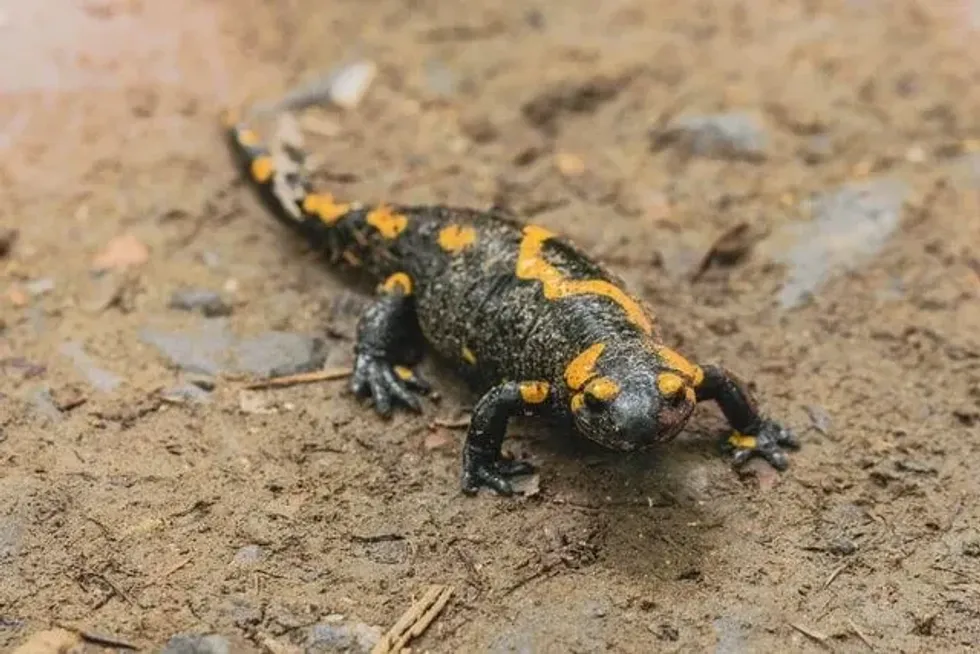Hellbender (Cryptobranchus alleganiensis) has a flat head and body, their skin is slimy, and have an attentive dorsal eye. They are also known as devil dog, mud devil, snot otter, and Allegheny alligator.
They have short legs and have five toes on their back legs and four toes on the front legs just like other salamanders, their tails are overturned which helps them to lock the tail under a rock.
Hellbenders have active lungs but only newborn hellbenders have gills adult hellbenders absorb water through their skin. There are two subspecies of hellbenders known as the Eastern hellbenders and the Ozark hellbender salamander.
If you liked these true facts about hellbender salamander, then you'll surely like these facts about the Surinam toad and the common toad too!
Hellbender Salamander Interesting Facts
What type of animal is a hellbender salamander?
The hellbender (Cryptobranchus alleganiensis) is a species of are aquatic salamanders originating from the Central Unites States, belonging to the family of Cryptobranchidae. The hellbender salamander's size makes them the third-largest salamander other two being Chinese giant salamanders and Japanese giant salamanders.
In its geographic range, hellbenders are the largest and use an uncommon way of breathing with the help of their skin.
What class of animal does a hellbender salamander belong to?
Hellbender (cryptobranchus alleganiensis) belongs to the class of Amphibian, they are cold-blooded, four-limbed vertebrates. Amphibians mostly inhabit arboreal, fresh aquatic ecosystem, terrestrial, and subterranean places. An amphibian is a creature that has the ability to breathe both on land and under water.
How many hellbender salamanders are there in the world?
There is a decline in the hellbender population and has decreased to only 590 individuals currently present in the wild which contains the two subspecies, the Ozark hellbender and the Eastern hellbender.
Where does a hellbender salamander live?
Hellbender's nests are found in a place with large, isolated, irregular rock with water streams moving briskly, they avoid muddy and slow-flowing New York to northern water as it affects their breathing process.
What is a hellbender salamander's habitat?
Hellbender salamander habitat is present in many areas of the United States including New York, northern Carolina, Georgia, Pennsylvania, West Virginia, Kentucky, Indiana, South Carolina, Mississippi, Missouri, Kansas, Ohio, Maryland, Virginia, Illinois, Tennessee, Alabama, Arkansas, and Oklahoma.
Who do hellbender salamanders live with?
Hellbenders are usually found alone, they are solitary in nature but during mating season a female is allowed to enter the nest, though they are pushed out after laying their eggs.
How long does a hellbender salamander live?
A hellbender's lifespan is up to 30 years of age in the wild, with proper care and a good diet, their lifespan can be prolonged to 50 years in captivity.
How do they reproduce?
The breeding season of hellbenders starts in August and goes on until November. At five years of age, they reach their sexual maturity and start breeding. Males display sexual zygotes only during the breeding season, during this period they project out their cloacal glands and they fertilize the eggs externally.
During the breeding season, a male first prepares a site which is usually under a rock or tree log pointing towards the downstream. Once a female approaches the site, the male will guide her inside and restraint them until they spawn.
Over a period of three days, a female hellbender lays 150-200 eggs which are connected to more than 10 chords. When a female spawns the male will position himself just above them and spray the sperms on eggs.
Males offer other females to lay eggs in their nest, but after the females lay eggs males will drive the females away and incubate the eggs themselves for 50-75 days. Cannibalism of eggs is very common in hellbenders.
What is their conservation status?
The hellbender (cryptobranchus alleganiensis) population has seen a drastic decline in many places.
Due to climate change and changes made by humans in the natural environment such as the setting of waste in water bodies, construction of dams, and many other factors like pollution, overharvesting these creatures in the name of science is responsible for the decline in the population of Hellbenders.
As per IUCN Red List, the Ozark hellbender salamanders are enlisted as endangered and the eastern hellbender salamander is enlisted as Near Threatened.
A population survey is conducted by the U.S Fish and wildlife service every year to keep an eye on their conservation status and to protect them from predators including water snakes, otters, and raccoons.
Hellbender Salamander Fun Facts
What do hellbender salamanders look like?

A Hellbender salamander's face is flat with gleaming dorsal eyes, they are considered the largest amphibians in North America and the third largest aquatic salamander in the world. Hellbender salamander teeth are small, with two cusps arrange in a single row.
They are slimy with wrinkled skin flat body having single open gill slits on both sides of the body.
They have four toes on their front legs and 5 toes on their back legs. Both subspecies of giant hellbender salamander Ozark and the eastern hellbender are found together only in Missouri where both the subspecies of aquatic hellbender are found together in the same habitat.
How cute are they?
Hellbenders are not cute at all, with their heinous and slimy and wrinkled skin they are not a treat for your eyes. They grow up to 24 in (2 feet) long weighing up to 30 kg. Locally they are also known as lasagna lizard, devil dog, Allegheny alligator, mud devil, and snot otter.
How do they communicate?
Hellbenders communicate through pheromones and use their motion sensory to avoid predators. Hellbender's skin is extremely slimy due to the mucus created by them, they use the same mucus in a large quantity to escape from the predators.
How big is a hellbender salamander?
An adult eastern hellbender (Cryptobranchus alleganiensis) can grow up to 9.4-15.7 in (24-40 cm). They are considered the largest amphibians in North America and the fourth largest aquatic salamander in the world.
How fast can a hellbender salamander move?
It is very rare to find hellbenders swimming, they are usually found slogging around the river streams using their small legs and pads on their toes.
How much does a hellbender salamander weigh?
A fully grown hellbender can weigh up t0 66.1 lb (30 kg). Compared to the other species they are the third-largest in the world right after the Chinese giant salamander and the Japanese giant salamander. Their weight is similar to a fully grown female Dobermann.
What are their male and female names of the species?
At present, no particular names have been assigned to the specific genders of hellbenders.
What would you call a baby hellbender salamander?
Unfortunately, a baby hellbender has not been given a specific name and is known as a baby hellbender or small hellbender. They are around 25-35 mm long as they hatch lacking limbs. Baby hellbenders breathe with the help of their external gills which sheds after 24- 36 months.
What do they eat?
Hellbender mainly eats crayfish but during the winter season when there is scarce of food they tend to survive on fishes. Sometimes they eat their own spawn.
Are they poisonous?
No, hellbenders are not poisonous at all, though earlier some fishermen believed them to be poisonous, which is not true, and hunted them. This led to the decline of their population and these aquatic salamanders were enlisted as endangered species and near threatened (depending on the subspecies).
Would they make a good pet?
Both species of hellbenders are enlisted as Near Threatened and Endangered, so a hellbender salamander pet is out of the question for you as they are illegal and under strict conservation efforts. They are bred in captivity only for scientific studies.
Their required habitat is difficult to be created in a normal household as they require a swift-flowing water stream for the breathing process.
Did you know...
Baby hellbenders are born with gills and they shed their gills after two or three years, and start behaving like adults.
They have been on Earth for more than 150 million years.
They require fast-flowing river streams to absorb oxygen from the water through their skin. If they end up in a slow-moving water stream, they might end up losing their life.
Due to the fact that they breathe through their skin if the water is not clear they will have problems with their respiratory systems. They are mostly dependent on their bodily senses, the muddy water may affect them, and might have issues of poor eyesight.
Their flat tails help them to accurately place them under a rock on a river bed making them difficult to find.
Hellbenders are extremely slimy, covered in mucus. It helps them in fleeing from their predators, parasites, or if someone tries to catch them. They create this mucus from their skin which makes them hard to hold or catch.
The eastern hellbender moves upstream on the river bed and searches for fish with the help of their good sense of smell. While hunting they use both their body senses as well as their excellent senses of smell.
They are not poisonous but a hellbender salamander bite can make holes in your skin with their sharp and tiny teeth, they are sometimes seen swallowing prey that is almost the same size as them.
The three largest salamanders are found in United States, China, and Japan.
With the help of the U.S Fish and Wildlife Service, both the Ozark hellbender and the eastern hellbender were added into appendix III of CITES (Convention on International Trade in Endangered Species) to be protected from International Trade and help to prevent a further decline in their population.
How does a hellbender salamander attack its prey?
Hellbenders is a species that will wait in their exact position days, concealing themselves on the river bed under the rocks keeping their heads visible, and ambush crayfish and other small fishes. It is also found that an adult can swallow their prey which is more than half of their own size.
What is a single hellbender salamander's range?
Hellbenders are a species that do not move around very frequently, if hellbenders find a favorable location in the river bed, it tends to spend a lot of time moving from there. The hellbender salamander range overlaps with other salamanders but they prefer solitude.
They are seen out of their favorite location only during mating season or during dusk when they search for their prey. Continuous climate change and changes made by the human construction of dams have caused their habitat to disappear and their population to decline.
Here at Kidadl, we have carefully created lots of interesting family-friendly animal facts for everyone to discover! Learn more about some other amphibians including the marine toad and the red-eyed tree frog.
You can even occupy yourself at home by drawing one of our Hellbender coloring pages.










